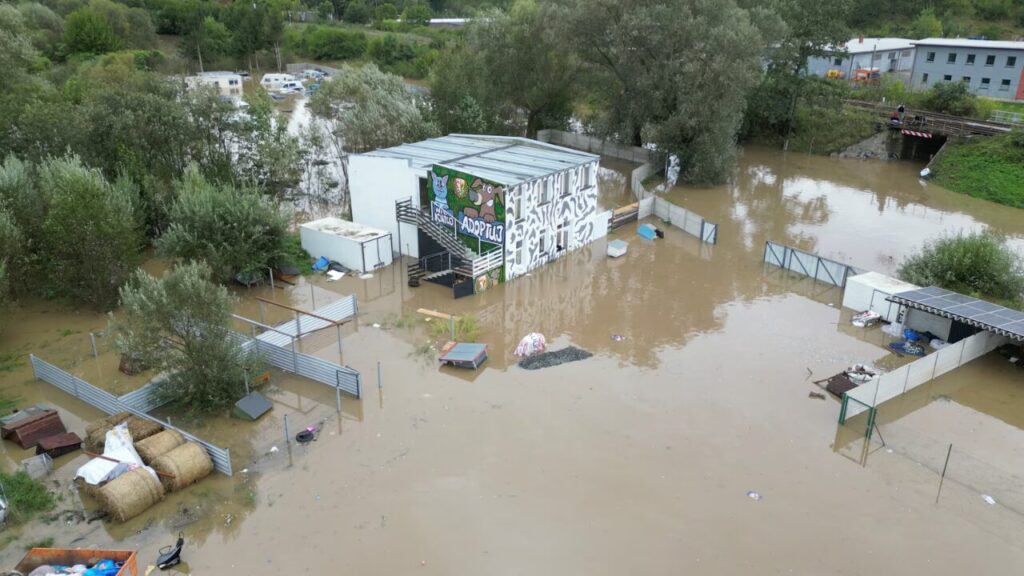The central Europe floods have ravaged countries like Poland, Romania, Austria, and the Czech Republic, causing widespread destruction. Heavy rainfall has triggered rivers to overflow their banks, submerging entire towns and cutting off villages. Over 10 people have died, with thousands forced to evacuate.
Widespread Impact and Evacuations

The flooding is most severe in northeastern Czech Republic, southwestern Poland, and eastern Romania. Rivers such as the Oder and Morava have reached dangerous levels, submerging towns like Krnov and Cesky Tesin. The city of Opava, located in the Czech Republic, saw 10,000 residents evacuated, and Ostrava faced major disruptions as the flooding led to power plant shutdowns. Authorities in Lower Austria declared a state of disaster as households were left without power and more evacuations were ordered.
Infrastructure Devastation

The floods caused extensive infrastructure damage across the region. Along the Czech-Polish border, bridges collapsed and roads were washed away, leaving many areas cut off. Towns in the Jeseniky mountains faced destruction of homes and roads. Helicopters were dispatched to conduct emergency evacuations in hard-to-reach areas, while highways and railways, including the major D1 highway, were shut down.
Emergency Response and Humanitarian Efforts
Governments in Central Europe have been working tirelessly to manage the crisis. Czech Prime Minister Petr Fiala announced that saving lives remains the top priority, deploying military personnel to aid in evacuations. Austria also braced for further rain, with Chancellor Karl Nehammer warning of worsening conditions.
The severity of the central Europe floods has made relief efforts challenging. In Poland, Prime Minister Donald Tusk described the situation as “dramatic,” particularly in Klodzko, where homes and bridges were destroyed. Authorities have set up temporary shelters for displaced residents and continue to provide essential food and medical aid.
Rising Danube Poses Further Threats
The central Europe floods have not been confined to Poland, Romania, and the Czech Republic. The River Danube continues to rise, threatening further devastation in Bratislava (Slovakia) and Budapest (Hungary). Local authorities are preparing for potential evacuations as the water levels climb to dangerous heights.
In Romania, six people have died due to the flooding, with large parts of the eastern region submerged. In Austria, a firefighter tragically died while responding to the floods, and Poland reported additional casualties, including a man who drowned.
Climate Change and Record-Breaking Rainfall
The catastrophic central Europe floods follow what scientists have recorded as Earth’s hottest summer. The extreme weather is tied to the build-up of moisture in the atmosphere caused by the heatwave earlier in the month. Experts have warned that climate change is increasing the likelihood and intensity of such extreme rainfall events. The floods highlight the urgent need for measures to mitigate the effects of climate change.
In Austria, the situation along the Kamp River remains critical. The Ottenstein reservoir, which serves as a buffer, is nearing its capacity. Emergency personnel continue to work to reinforce flood defenses, but the continued heavy rainfall is putting pressure on the water management system.
International Support and Aid
As rescue efforts continue, European Commission President Ursula von der Leyen has pledged EU support for the nations affected by the central Europe floods. Emergency aid is being coordinated to provide immediate resources for displaced families and to begin repairing the damaged infrastructure. However, the recovery process is expected to be long and difficult.
The flooding has left thousands of homes submerged and cut power to hundreds of thousands of residents. Local governments warn that it could take months for life to return to normal in the worst-affected regions, and many are already beginning the arduous process of rebuilding their homes and communities.
An Ongoing Crisis
The central Europe floods have caused a trail of destruction, and the situation remains critical as rivers continue to rise and heavy rainfall shows no signs of abating. The resilience of local communities, combined with the tireless efforts of rescue workers, shines through in this difficult time, but with more rain forecasted, the next few days will be crucial.
Governments and relief organizations continue to work around the clock to ensure the safety of residents and to mitigate the long-term impact of this disaster. As the affected nations come to grips with the aftermath, they brace for further challenges in the coming days.

Hiya, I’m really glad I have found this information. Today bloggers publish only about gossips and net and this is actually annoying. A good website with interesting content, that is what I need. Thanks for keeping this site, I will be visiting it. Do you do newsletters? Can not find it.
Thank you so much for taking the time to share your thoughts! Your feedback means the world to us and helps make our site even better. We love hearing your perspectives and ideas, so keep them coming. Whether it’s a question, suggestion, or just sharing your experiences, we truly appreciate your engagement. Stay tuned for more exciting content, and don’t hesitate to let us know how we can make your experience even better!